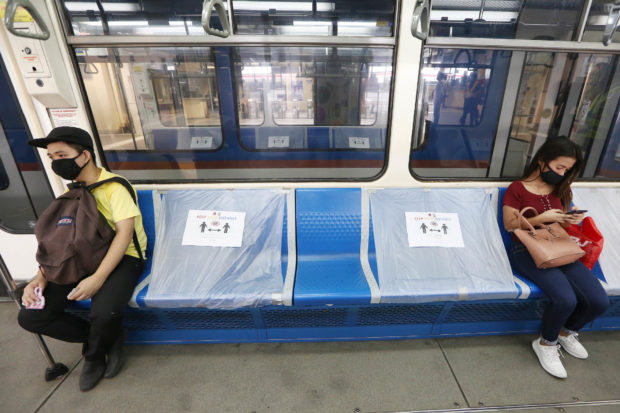Metro Manila trains to transport more passengers

INQUIRER FILE PHOTO / NINO JESUS ORBETA
MANILA, Philippines — Metro Manila’s three elevated rail transports and Philippine National Railways (PNR) are expanding capacity beginning Monday to carry more commuters as the country tries to rise from economic slump due to the coronavirus pandemic, the Department of Transportation (DOTr) said on Sunday.
The government will also allow motorcycles to run as taxis to give commuters another public transport option, Interior Secretary Eduardo Año said.
Metro Rail Transit Line 3 (MRT 3) and Light Rail Transit Lines 1 and 2 and PNR are running at 30 percent capacity from Monday before gradually expanding their passenger load to 50 percent, the DOTr said.
The four rail services have been operating at 13 percent to 18 percent capacity since the easing of a hard lockdown in June.
Public transport guidelines
The capacity boost, with the implementation of the one-seat-apart rule, will allow a maximum of 372 passengers per train on MRT 3, 370 on LRT 1, 486 on LRT 2, and from 179 to 302 on PNR’s ground-level trains.
Article continues after this advertisementGuidelines issued last week by the Land Transportation Franchising and Regulatory Board require passengers to sit one seat apart from each other on all public utility vehicles. They may sit side by side, however, if there are plastic barriers separating them.
Article continues after this advertisementMarshals are deployed to train stations and aboard trains to make sure passengers observe the minimum health standards—wearing masks and face shields, do not eat or talk to each other or on cell phones—and the social distancing rule.
The marshals also check if public transports are well ventilated and see to it that people with COVID-19 symptoms are not allowed aboard.
In a radio interview on Sunday, Año said a resolution had been submitted to Congress to allow trial runs for motorcycle taxis pending the issuance of franchises to operators during the pandemic.
Año said the reopening of 75 percent to 100 percent of businesses would have 400,000 workers more fighting for space on public transports, and motorcycle taxis could be an option for them.
“They would be a big help,” Año said.
He said motorcycle taxis would be allowed on the road as long as they have the prescribed barrier between drivers and passengers and passengers wore crash helmets.
Bring your own helmets
Año encouraged commuters who would use motorcycle taxis to bring their own crash helmets, stressing that it was not a requirement but just a suggestion to protect passengers from coronavirus transmission.
Commenting on the one-seat-apart rule, Año said this eased measure would be recalled if the country was hit by another wave of infections, and that stringent rules for public transport would be reimposed.
In a television interview on Sunday, Restituto Padilla Jr., spokesperson for the National Task Force Against COVID-19, said travel passes were no longer required for movement between areas under the same quarantine classification.
For “interzonal” travel, he said, local governments would set the rules.
Padilla also said Filipinos were now allowed to travel overseas provided they signed a waiver stating that they were aware of the risks to their health, could submit other requirements, and willing to be subject to health restrictions in their destination countries.
—With a report from Jeannette I. Andrade
For more news about the novel coronavirus click here.
What you need to know about Coronavirus.
For more information on COVID-19, call the DOH Hotline: (02) 86517800 local 1149/1150.
The Inquirer Foundation supports our healthcare frontliners and is still accepting cash donations to be deposited at Banco de Oro (BDO) current account #007960018860 or donate through PayMaya using this link.